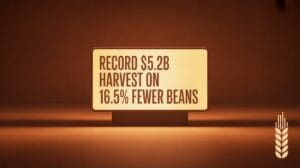How did Vietnamese coffee jump so fast into Canada? Reporters note that emerging consumer trends and Canadian retail dynamics played large roles. Shoppers in Canada are looking for new flavors and better value. Retailers responded by adding more imported options. Vietnamese coffee arrived at the right time, with marketing aimed at curious consumers and the Vietnamese diaspora.
Officials say Vietnam’s export growth has been striking. Exports reached record volumes and values in recent crop years. Producers increased output, mostly robusta, and shifted some supply toward processed coffee. Prices rose globally, but Vietnam still offered competitive products. Trade deals like CPTPP and other agreements lowered barriers. That made it easier and cheaper to ship coffee to Canada.
Vietnam’s coffee exports surged—record volumes, more processed robusta, competitive prices and trade deals eased shipments to Canada.
Industry groups worked to connect growers and Canadian buyers. Events in Toronto brought roasters, café owners, and importers together. Those meetings helped product trials in local shops and restaurants. The Trade Office and coffee associations pushed traceability and quality. They highlighted roasted and soluble coffee as well as green beans.
Statistics show strong gains. Exports to Canada climbed sharply after trade changes. The value surged from about $10 million to nearly $40 million. Volume grew too, though Canada still takes a small share of Vietnam’s total output. United Nations trade data confirm rising shipments under coffee, tea, mate, and spices. Much of the export value to Canada is for coffee specifically.
Canadian cafés and grocery chains began stocking Vietnamese brands. Some chains tested blends in stores. Small roasters added Vietnamese beans to their menus. That broadened consumer choice and raised awareness. At the same time, Vietnamese companies invested in processing and traceability. Those investments made products more appealing to importers who want consistent quality.
Vietnam’s domestic market also strengthened. More coffee shops at home and rising local demand helped firms scale. Higher production and better processing meant firms could export more finished goods. Observers say the mix of trade policy, industry outreach, rising output, and shifting shopper tastes explains the rapid rise. Canadian coffee sellers now face new competition from a fast-growing Vietnamese supply. traceability





